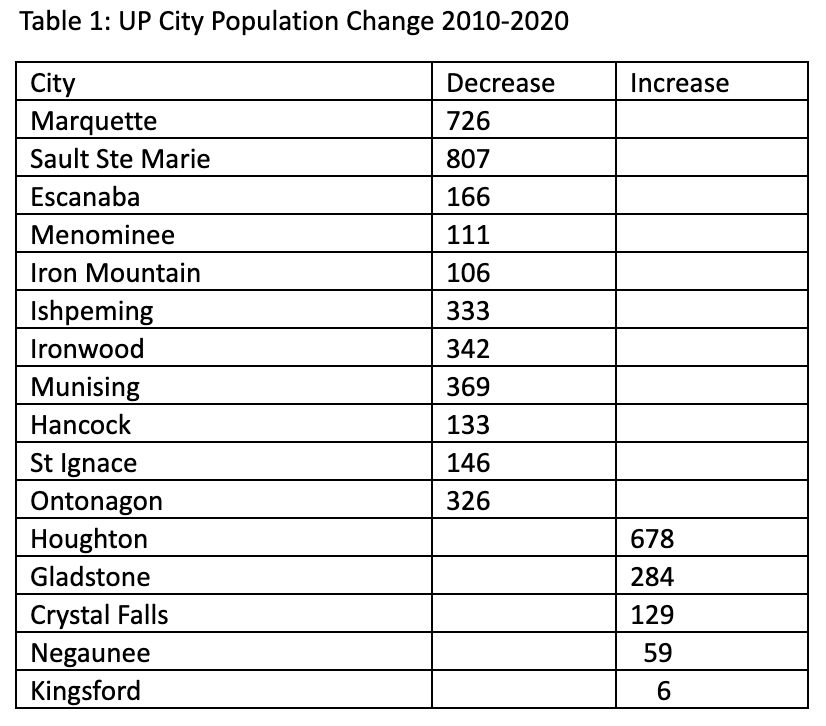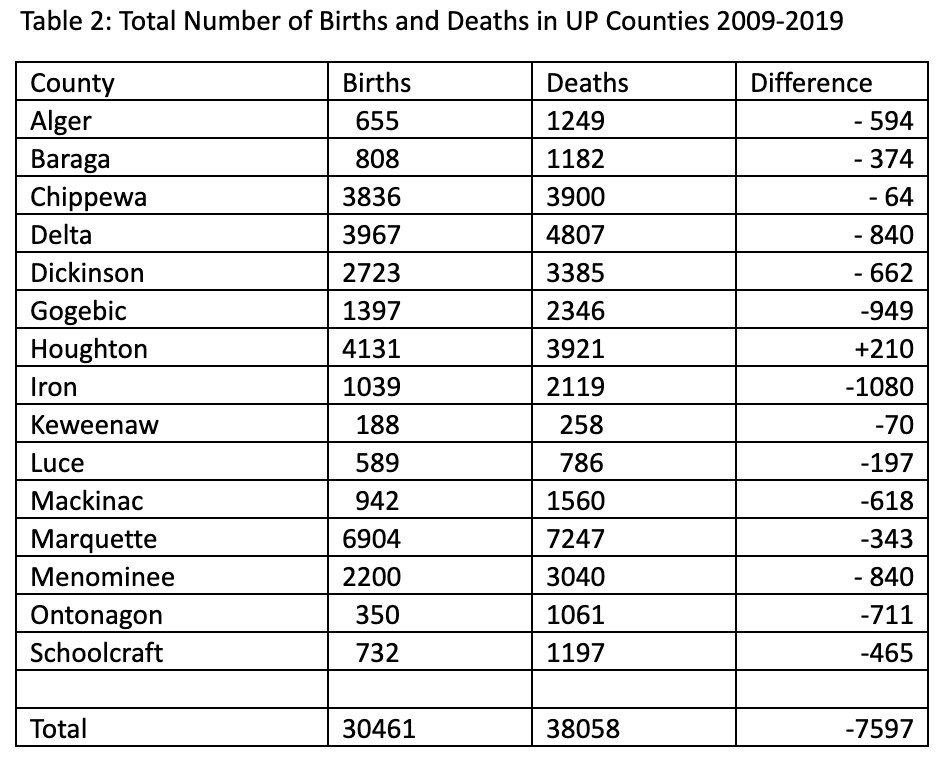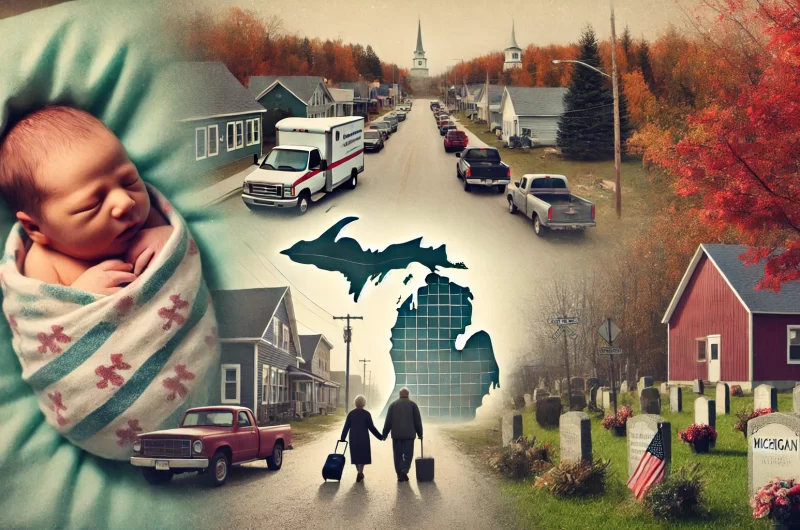The UP at a Crossroads: Beyond the 2020 Census Results

Earlier this year, the US Census Bureau announced its 2020 Census results.
Michigan’s headlines: between 2010 and 2020 the state’s population grew by about 200,000 people, with much of the growth concentrated along the Lower Peninsula’s Lake Michigan shoreline.
In contrast, the Upper Peninsula’s population decreased by about 10,000. The 15 counties that comprise the UP have an official 2020 population of 301,608, down from 311,631 in 2010. The 2020 population is the region’s lowest total for more than 60 years; only Houghton County experienced a gain (733 residents) between 2010 and 2020.
The CEO of InvestUP, a regional economic development agency, commenting on the census results noted to Mlive: “It’s not sustainable. It’s something we need to find a course correction for to have any chance to thrive.”
The issue of population decline is not unique to the Upper Peninsula–rather, it is a feature of most rural areas in western industrialized countries. The decline, or depopulation, is driven by a falling birth rate, a lack of in-migration and long-term changes in industries that have historically underpinned rural economies, like agriculture, forestry, and mining.
Simply put, fewer people are needed to work in these industries, and with fewer locally available jobs people leave rural areas to find work in cities. In the past, this outmigration was offset by high birth rates, but this is no longer the case; birth rates are falling while an aging population drives up deaths.
The net effect of these processes is population decline.
The remainder of this article provides an overview of the UP’s 2020 census results and examines the principal drivers of the region’s population change: the birth rate, the death rate, and migration.
Rural depopulation has been occurring in the UP for a long time. The peak population in eleven UP counties occurred prior to 1951 when the local resource-based economy was booming, which drew immigrants and internal migrants to the area.
Houghton County’s population, for example, peaked in 1910 at 88,098 at the height of the copper mining boom. Even with its recent modest population gain, the county’s 2020 population is still 50,000 less than its 1910 peak.
For the 2010-2020 period, the largest population losses in percentage terms occurred along the eastern shore of Lake Superior in Luce county (-19.4%) and Alger county (-8%), and in the western UP’s counties of Ontonagon (-14%), Gogebic (-12%), and Baraga (-8%).
The remaining counties’ losses were 5 percent or less. The largest absolute population loss (2047) occurred in Gogebic County and is tied to the 2018 closure of the Ojibway Correctional Facility in Marenisco Township. The facility employed about 200 workers and housed approximately 1100 inmates; in Michigan, inmates are counted as part of a county’s population.
Population declined in most of the region’s cities (Table 1), with the largest absolute declines occurring in Sault Ste Marie, Marquette and Munising, while Houghton and Gladstone experienced the largest gains. The region’s population decline is due to the number of deaths exceeding the number of births (Table 2), while the number of people migrating to the region is insufficient to offset the difference.
According to data from the Michigan Department of Health and Human Services, between 2009 and 2019 the number of births for the 15 UP counties amounted to 30,461, while the number of deaths was 38,058, a difference of 7597. These differences can be seen at the county level.
Iron County, for example, located along the Wisconsin border, had over a thousand more deaths than births during the ten year period; in Gogebic County the figure was 949. In Marquette, the UP’s most populous county, the number of births amounted to 6904 while the number of deaths totaled 7247, a deficit of 343 persons.
The only county where there were more births than deaths is Houghton: the same county that experienced a population gain between 2010 and 2020.
The discrepancy between births and deaths is unlikely to be easily rectified given the long term decline in the average number of children a woman has in her lifetime–a figure referred to as the fertility rate.
The CDC reports a current rate of 1.6, considerably below 1960’s 3.6. A fertility rate of 2.1 is required for a population to maintain its population from one generation to the next.
Looking ahead, the UP’s aging population will continue to push up the number of deaths. The median age in Iron, Keweenaw, Mackinac, Ontonagon and Schoolcraft counties is over 50, while only Houghton (33.0) and Marquette (39.1) have values below 40.
The other means of increasing population is to attract people to settle in the region. The rise of remote working means people who formerly lived in the UP and moved away because of lack of employment could be targeted by municipal projects that would facilitate their return, including increasing broadband access.
Some states offer incentives; West Virginia, for example, pays people $12,000 to relocate to the Mountaineer state under its Ascend WV program. Ireland has an ambitious 5-year plan to decentralize 20 percent of government employees to 400 remote worker sites in rural areas.
Without an ambitious effort to attract newcomers and an accompanying increase in the tax base, it will be difficult for local governments to maintain existing services, which in turn will make it difficult to retain existing residents, leading to a further downward spiral in the region’s population.
Houghton County’s population growth shows that population decline is not inevitable. Its growth is linked to the area’s successful efforts to attract and develop new high tech businesses through the Michigan Tech Enterprise SmartZone that have added hundreds of new jobs.
Marquette and Sault Ste Marie have launched similar ventures–time will tell if they yield comparable results. Without strong leadership from the state government and other institutions, counties will be severely challenged by the forces of population decline in the next decade.









Excellent article I will definitely be reading a lot more about the Upper Peninsula through your articles.
I definitely will be doing a lot of brainstorming in the very near future and future of the Upper Peninsula.
States like Indiana are ahead of the game by creating incentives to attract climate refugees from across the US to help fill jobs and keep schools and businesses vital. Michigan should follow suit as the population declines across the state, including Northern Michigan and the UP could see economic hardship without an influx of young people and families.
Remote work is also having a favorable impact on Houghton County. The Remote Workforce Keweenaw initiative started in 2018 (https://remoteworkforcekeweenaw.com) is promoting the region to individuals who embrace winter and would value ubiquitous natural beauty in an environment with no congestion with lower crime. Learn about those making the decision to locate here by following our ongoing series of vignettes on the Remote Workforce Keweenaw Facebook page at https://www.facebook.com/RemoteWorkforceKeweenaw
I enjoy reading the Broadway’s articles on rural issues. Institutions like InvestUP are so necessary for supporting business initiatives that will attract and retain a work force in the UP. I am also hopeful now with remote work becoming a reality that younger people who had to leave the area for their professions can return home because know and want the lifestyle available in Marquette County and the Upper Peninsula.
The idea that Marquette can create sustainable growth through the expansion of high-priced housing marketed to people who would only be part-time residents in the hope that all that big money trickles down into the local economy? It benefits the few rather than the many…
And Tourism? An industry that is subject to whims, and unpredictable.
If the UP is to grow, people need to decide what kind of growth they wish to have that will either keep the status quo or accept that changing the landscape might lead to something no one really wants: a reduction in the vast natural beauty that is the UP.
You’ve got that right.
I would like to see the following paradox addressed: Despite population decline and the addition of many new condos and neighborhoods in the past 10+ years, we are told Marquette has a housing deficit – especially affordable housing. Seems counter intuitive – build more houses, lose population and the end result is higher prices and a housing shortage? Reasons would seem to include: 1. Much of the new housing is going to temporary / part time residents – who are able to pay more, pushing prices higher. 2. Housing units are being shifted to short term rentals vs. long term rentals or affordable homes for homeowners.
Or how about addressing this paradox: If new development and giving tax breaks to developers were going to fix the problem, it seems the problem would be fixed by now. Just look at the the housing and commercial development in the last 10 – 20 years! Since those who own 2nd homes (or short term rentals) pay a higher property tax, it seems that would help the tax base and we should be doing OK. Unfortunately, we never hear of budget surpluses and improved services from local governments. Snow plowing, for instance, just isn’t the same as it was when I moved here 30 years ago – whether on roads plowed by municipalities or counties. The numbers just don’t add up.
High speed satellite internet (Starlink) is going to significantly help in attracting people to relocate to rural areas. I personally just relocated to a remote property in rural Baraga County, because I could bring my Starlink satellite system with us. I work remotely from home, and fast internet services was the deciding factor. Now I can continue to work from home, and enjoy the vast beauty of the UP.
Steve, the Remote Workforce Keweenaw initiative would be interested in talking to you about your success with Starlink! We featured a UW-Madison professor (check out the Remote Workforce Keweenaw Facebook page for this and other remote worker vignettes) who was able to successfully teach via Starlink from the Keweenaw. Starlink represents a huge opportunity for our region!
I am not sure that young people in particular will be eager to locate to rural areas, high speed internet such as Starlink notwithstanding. In my experience, young people want to be around other young people. Youth flock to places like the Twin Cities to be with those their age. I would like to see a large investment in higher education for rural America; i.e., more support for colleges and universities, such as free tuition, housing and transportation subsidies, etc. I am glad that Michigan Tech is holding its own with 7.320 enrolled FTS in the fall of 2023, the highest since 1983. Although Northern Michigan U is up from the Covid years to 7,197, it is significantly down from 9,273 in 2010, which is a cause for concern. In addition, Finlandia U is defunct: This is a significant loss for the Keweenaw and the UP-entire Lake Superior Region. Let’s invest in education!
You may want to add that a factor in Luce County’s large population loss was a failure to properly count the population of inmates in the 2020 Census. This error cannot be fully corrected in the Census, either, particularly when it comes to redistricting.
An additional factor in the population growth in Houghton County has been the steady increase in individuals coming to the county to work remotely. Since 2018, the Remote Workforce Keweenaw initiative has been encouraging individuals with the ability to work remotely who embrace winter and would value living in a place with ubiquitous natural beauty, no congestion, and lower crime to consider locating in the Keweenaw. Covid has radically changed employers’ willingness to allow this approach to employment. With a product that is second to very few, our region is well positioned to leverage this trend. With a focus on winter our objective is to make it clear that our area isn’t for everyone, but for that small segment of the bell curve that does appreciate what we have to offer it does not get much better than this! The salaries coming in with these workers are strong contributors to our economy (construction, services, and retail) and are paid by employers outside the region. Learn more about the initiative by clicking on my name and by following the Remote Workforce Keweenaw Facebook page to follow our ongoing series of vignettes about remote workers who have come to the region.
I live in Royal Oak & have a home in Houghton County. My health insurer demands 30% payment for services in Houghton & most other counties in the U.P.. I was told to drive to Wisconsin to get full coverage. A friend was treated for Cancer in Houghton, but was told the Oncologist was leaving area. He was the only Oncologist. I believe he is being treated by his primary physician.. I remember a very good doctor in Laurium moved out of the area because his wife couldn’t the handle winter weather.The health service in the U.P. is considered by many to be notoriously bad.
I wanted to share my thoughts about the health care offerings in Houghton County. I’m one of those snow lovers who relocated to the Keweenaw from southwest Florida when I retired. I had a number of health issues when I retired, and was concerned that I would have to travel out of the area to access quality health care. This has not proven to be true for me at all. My primary physician is excellent. I had hip replacement surgery this past summer. The care I received at Portage was superb, as was the rehab care I received in Houghton. After 4 years of living in the Copper Country, my only thought is how grateful I am to live in a rural area with such good health care. Thanks for letting me shsre.
The UP does have quality healthcare. As long as I have lived in Marquette (since 1990), there has always been this dynamic that healthcare elsewhere is always better. Not always true. However, it has been a challenge to keep some physician specialists and yes, some due to spouses not liking the area. But many do like the area and especially for raising families. As for healthcare insurance that Gary Benchich speaks of, that will always be an issue as health insurers negotiate rates with networks. Lifepoint owns both UPHealth – MQT, Bell and Portage, so perhaps that will change. The healthcare dynamic in the UP is ever fluid, dynamic and I imagine we will be seeing changes again in the near future.
What’s needed is set of questions and their most likely answers. 1. Besides seasonal tourism, where would substantial private job growth come from. 2. Major employers are publicly supported, education, hospitals, local government services. Can/will the State if Michigan continue to fund, from downstate taxes, the subsidies given to UP counties to maintain basic services. 3.If there is not a sufficient and qualified labor force now to fill present jobs, why would potential employers consider the UP. 4. What attempts at regional planning and development have worked in the UP and what were the factors that produced success. 5. Are there enough people in positions of influence and with necessary support, skills and leadership to lead the needed actions. 6. Collectively do Yoopers really care about this situation or want anything to change
One of the most challenging aspects of this issue is that a large majority of current residents don’t believe there is a population issue. I know a few of them.
The other challenging aspect is that small towns don’t have planning teams and rural regions need a clear “regional planning organization” to compete for state funding with urban areas. And nothing seems to happen without state funding.
[…] U.P.’s population has been dropping for years, but there are still about 300,000 Yoopers—most of whom would prefer not to be wiped off the […]
Everything rests on money. We live here because of low population and the beauty of this place. New comers don’t understand the nature of the Yooper lifestyle. They change our local and township governments to suit their own needs.
I was a rural mail carrier for years, sometimes 11 miles between houses. More often than not, the new comer along my route was rude and demanding that their mail be delivered in a certain manner and at a certain time of day. That is not always possible in the winter months.
I have witnessed dreamy eyed folks come to the U.P. buy up property only to leave after a couple of years. The winters can be brutal and pizza delivery is out of the question out here.
On the flipside, the rural U.P. is a wonderful place to raise a family with homesteading and homeschooling offering the very best learning experience. Please leave big city crime and mentality in the big cities.